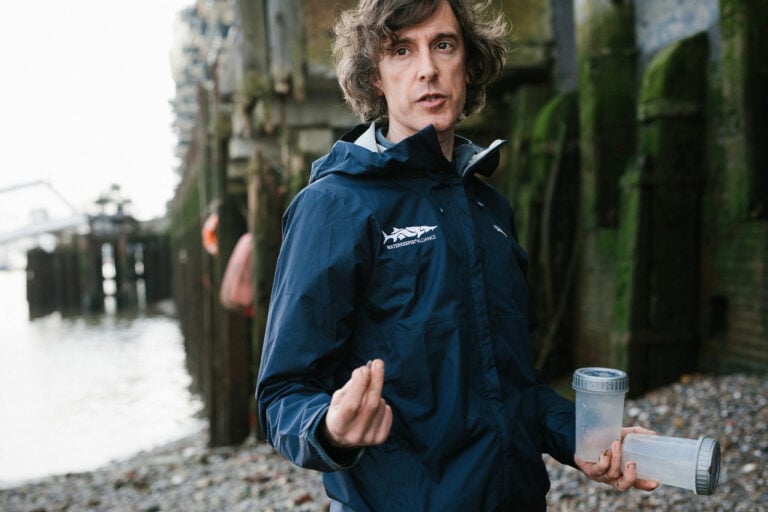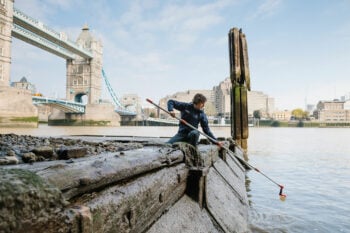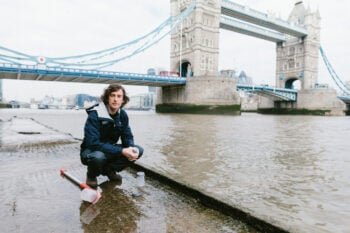Who Is Waterkeeper: Theo Thomas, London Waterkeeper
By: Thomas Hynes

The city of London was founded nearly 2,000 years ago by the Romans, who initially called it Londinium. Since that time, London has established itself as one of the most historically significant, culturally important and densely populated cities in the world, home to nearly 9 million people. This ancient and crowded combination can pose a significant threat and many challenges to the city’s many waterways.
The River Thames is certainly the most widely known river in London, but it’s by no means the only one. There are over two dozen other rivers in the area that all flow into the Thames, as well several lakes, ponds, and canals.
When Theo Thomas formed London Waterkeeper in 2014, he could have easily been just the Thames Riverkeeper. However, he didn’t want to overlook all those other waterbodies. He also saw an opportunity to make the connection that upstream pollution affects not just the Thames, but really the whole of London.
Before forming London Waterkeeper, Theo worked for a more traditional environmental organization that had him ‘on and around’ rivers. His work there was centered around mitigation and cleanups, but rarely focused on any of the root causes, or anything systemic. When he learned about the Waterkeeper movement, he saw an opportunity to pursue more effective and efficient advocacy work. It was specifically the notion of people speaking up for their rivers that inspired him most.

“I thought there needs to be an independent organization that doesn’t take funding from water companies and doesn’t have a conflict of interest, one that can operate in a way that candidly puts pressure on the authorities. I didn’t want to have just another charity,” says Theo. “Being part of Waterkeeper Alliance’s global network, to learn from them, connect with them, and have solidarity with them, that really spoke to me.”
Working to protect a jurisdiction that is home to millions of people in a city that is thousands of years old has presented Theo with plenty of challenges. One of the main threats to the health of London’s waterways is combined sewer overflow and storm runoff.
In 2013, the government informed water companies that they would need to fit all their overflow sites with monitors so they knew how frequently they discharged. They began that work in 2016. London’s sewers are managed by a private company, Thames Water, which also happens to be a monopoly. In 2017 London Waterkeeper asked the company to put the overflows online, in real-time, via a map. Theo also rallied supporters and helped generate additional requests from over 700 people.
Thames Water eventually agreed to meet with London Waterkeeper. However, three years later the live data still wasn’t online. Thames Water continued to stall, so a formal complaint to the information regulator followed. The regulator declined to act so London Waterkeeper prepared to start a Judicial Review against the water company. At a meeting in June 2021, Thames Water finally agreed to meet London Waterkeeper’s request, and in January 2023, an up-to-the-minute storm discharge map finally appeared online.
“Making it public can help awareness, but it can also drive investment,” says Theo. “This effort has led us to discover lots of places without permits or monitors and they’re now all online.”
Previously, Thames Water said they had only 468 sewer overflows locations. After reviewing, at London Waterkeeper’s behest, they discovered that number was actually nearer to 600. Just last December, London Waterkeeper got Thames Water to admit they had 128 additional discharge locations that had no monitors or permits. Thames Water initially hid this, but London residents, and their smartphone footage, showed the reality.
“You don’t need a lot of science tests to understand that a water body isn’t healthy,” says Theo. “If there are no fish and it’s murky, it’s a good indicator that it’s not right.”

Theo believes the next step is to stop rain from getting into the sewer in the first place. He sees green infrastructure and sustainable drainage as viable solutions to the problem of sewer overflow events by creating more places for rain to be absorbed close to where it falls. It would also make neighborhoods nicer, as this type green infrastructure usually means trees and plantings. Sadly, it seems that Thames Water is only planning to use this greener approach for about 6% of sewer overflows in London. Not surprisingly, Theo has asked to take a closer look at the water company’s plans.
“Underpinning all the problems is always a lack of accountability. Every problem is a matter of authorities getting away with something they shouldn’t be doing,” says Theo. “Having the data, knowing the law, and putting the right pressure allows us to be effective. It’s not an opinion. It’s facts, laws. It’s clear we’re right. And if it was just us doing it, that would be fine. But the more people that get involved, the more effective it becomes.”
Theo sees these efforts as beneficial in multiple ways. Aside from the many benefits this kind of transparency and accountability has given Londoners, it’s also been an empowering experience for London Waterkeeper and their supporters. Taking Thames Water to task allowed people to build up their advocacy skills, and get away from being reactive and just fretting about all the bad things that happen.
“If nothing gets done and nothing is investigated, it makes people feel powerless, downtrodden and disillusioned,” says Theo. “But, the better the data, and the better the transparency, the better the solutions will be.”